The History of 70mm Short Subjects |
Read more
at in70mm.com The 70mm Newsletter |
| Written by: Randy Gitsch, Presented live on Sunday, March 22, 2009 in Bradford's International Film Festival | Date: 11.04.2009 |
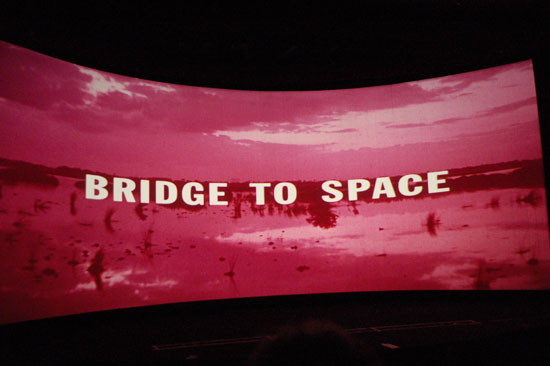 Good morning! I was to give you a short history of Cinerama short subject films, but discovered that despite my rather complete collections of Film Daily Yearbooks, International Motion Picture Almanacs, Harrison’s Reports, and a dozen or more Kinematograph Yearbooks, in addition to dozens of other film texts, these shorter films, as a body of work, just vanish in written film history. Good morning! I was to give you a short history of Cinerama short subject films, but discovered that despite my rather complete collections of Film Daily Yearbooks, International Motion Picture Almanacs, Harrison’s Reports, and a dozen or more Kinematograph Yearbooks, in addition to dozens of other film texts, these shorter films, as a body of work, just vanish in written film history.I therefore decided that the only way to introduce the following widescreen shorts might be to give you all a very, very abbreviated history of ALL widescreen short subjects. Thanks in large part to Carr & Hayes text Wide Screen Movies, and its extensive errata list, edited by Dan Sherlock, to which many of you have contributed, and to Keith Swadkins, a truncated history begins… The first widescreen short subject may have been shot here in England by Birt Acres of Barnet, (where I started Kindergarten, at Whitings Hill School), who in July 1896 shot a film entitled, “Henley Regatta” in 70mm. His film was projected at London’s Palace Theater on March 17, the following year. About the same time, give or take a year, Georges Demeny & Gaumont in France, Prestwich here in the U.K., and the American Mutoscope and Biograph Co., all were experimenting with wide film of 60, 62 or 63mm, although these films, with the exception of the film of the 1897 James Corbett-Bob Fitzsimmons prizefight, received little or no public exhibition. Thereafter, two startling, exciting images, screamed to be filmed in widescreen, which could be covered in a short length film fittingly. The FIRST was The Rollercoaster and the SECOND was Niagara Falls. In 1923 and 1926 George K. Spoor and P. John Berggren filmed short films of each to demonstrate their new 63mm Natural Vision process. Is it perhaps an homage to these films that a rollercoaster and Niagara Falls appear as the first and third sequences in "This is Cinerama", filmed a quarter of a century later? Simultaneously with the worldwide growing interest in widescreen feature presentation at this time. Newly created RKO Radio Pictures was sufficiently impressed by Natural Vision to film “Danger Lights”, a 1930 feature in the this process, along with a third Natural Vision short “Campus Sweethearts”, albeit they had a limited run at only one public venue in Chicago. |
More
in 70mm reading: Cinerama 70mm short subject remastering work completed “Broadsword Calling Danny Boy” Widescreen Weekend Report 2009 WSW 2009 program Widescreen Weekend Home Mr. Derren Nesbitt ("Major von Hapen" in "Where Eagles Dare") Lost Orphaned Films Abandoned in Basement Ramon's WSW review and Audience feedback Images: Friday, Saturday and Sunday "Audience on Stage" and Academy of the Wide Screen Weekend Film Introductions: "The Bible...in the beginning" "How the West Was Won" "Khartoum" "The King and I" "This is New Zealand" "West Side Story" "Faubourg 36" 70mm in Paris "This is New Zealand" 3-strip EXPO Film From New Zealand The M.C.S.-70 Process Internet link: |
 “Napoleon” in Triptych. “Napoleon” in Triptych.Meanwhile, in France, Abel Gance, was the man who used a three-camera, three-screen system during parts of his 1927 French epic motion picture “Napoleon”, and called his widescreen triptych, “Polyvision”. He also produced individual triptych shorts culled from “Napoleon” in 1928; “Danses” (2/10/1928) was the “Bal de victims” sequence from the feature. “Marine” (2/20/1928) was the name given to its’ short Seascapes montage. And “Galops” (2/10/1928) was the sequence of Napoleon’s escape from Corsica. The same year, Gance took a montage of scenes from the 1925 French picture, “Kristallen” and reedited them for Triptych screening, calling his this new short “Cristallisation”. Years later, after the worldwide success of Cinerama, and its playing in Paris, the short “14 Julliet 1953” was released. Directed by Gance, and produced by George Rosetti and Gaumont-Debrie companies, it featured sequences culled from “Napoleon”, perhaps with new material, and rumored by some to have been screened in Cinerama. The First Widescreen short subjects also included Paramount’s “You’re in the Army Now” (7/18/1929) starring Johnny Burke. Fox Studios released the “Fox Grandeur News” (9/17/1929) a special Fox newsreel, this time promoted as “Extra Wide Film on Extra Wide Screen”. Warner’s produced the “Larry Cebalos Review” (7/6/1930) in Vitascope, and again, because it screamed for widescreen short coverage, “Niagara Falls” (1930) was filmed in Fox’s Grandeur process, and released with the Grandeur process feature, “Happy Days”. With the retreat from widescreen after the early 1930’s there were few, if any widescreen shorts until the rebirth of the “Seeing Bigger, Seeing More…is Better” revolution started by the success of "This is Cinerama" in 1952. |
|
|
Slowly, widescreen short subjects began to be filmed again as demonstrations, if you will, to show off their very processes, but now to a smarter, more visually aware public audience. "The Miracle of Todd-AO" (1956) came out shortly after the feature "Oklahoma!". Its’ highlight content was a ride on a rollercoaster. In 1959, "The March of Todd-AO" followed. In 1960 came "The Tale of Old Whiff" filmed in Todd-AO and presented in Smell-O-Vision. It was a cartoon and came with 15 different smells. It accompanied “Scent of Mystery”, and its’ credited “Osmologist” was Prof. Hans Laube. Now there’s a credit you don’t see much. This was the first completely animated film photographed in 65mm. Also demonstrating their formats were the Paramount Vista Vision shorts, a series of nine (9) short travelogues, beginning in 1954, titled “Vista Vision Visits Norway”, then “Vista Vision Visits Hawaii”, then “…Japan”, “…Mexico”, “…Spain”, “…the Sun Trails”, “…Austria”, “…Gibraltar” and “…Panama” (1956). Also in Vista Vision, was the BFI-produced “A Door in the Wall” (1955), which used “Dynamic Frame”, a changing shape and size frame design, and “Williamsburg: The Story of a Patriot” (1957), an installation in the Williamsburg, VA, visitor center, and recently recently restored by Robert Harris. Repping their formats well, were also “Velet” (aka “Aeroport”) (1965) which was shot in Sovscope 70, in Tbilisi, Georgian Soviet Socialist Republic, and "Harmony: Nature and Man" (1970) was shot in the D 150 process, to be shown at the State of Washington’s Expo ’70. |
|
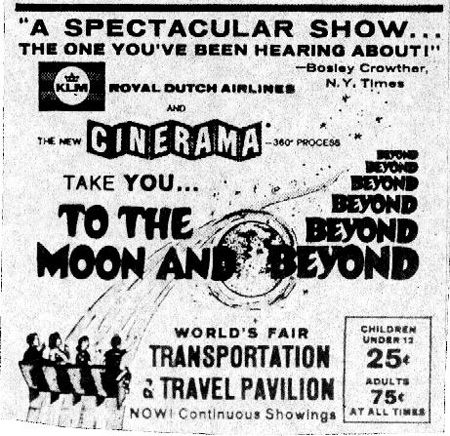 Cinerama, the leader of the widescreen revival in the ‘50’s & ‘60’s also began making short subjects, for theatrical exhibition and gradually for special installation venues at fairs and museums. “Journey to the Stars” (1962), in 70mm, was made for the Boeing Corp., to be screened at the Seattle World’s Fair, on a domed screen. “To the Moon and Beyond” was made for KLM Airlines, screened at the 1964 New York World’s Fair, on a domed screen there. After the fair, it was retitled “Cosmos: The Universe of Loren Eisley” and was shown in mobile theaters. “Shellarama” (1965) was filmed in Super Technirama 70. I see some smiles out there. This was a British theatrical commercial shown with the feature, “Battle of the Bulge”, for Shell Petroleum Company, and shot in Iran, Nigeria and England. You can apparently still book this one in 70mm from Shell in London, although now retitled, “Push Button Go”. And Cinerama’s "Fortress of Peace" (1964) was shot in Switzerland, and about the Swiss “citizen army”. It received an Academy Award nomination in 1966 for Best Live Action Short Subject. Cinerama, the leader of the widescreen revival in the ‘50’s & ‘60’s also began making short subjects, for theatrical exhibition and gradually for special installation venues at fairs and museums. “Journey to the Stars” (1962), in 70mm, was made for the Boeing Corp., to be screened at the Seattle World’s Fair, on a domed screen. “To the Moon and Beyond” was made for KLM Airlines, screened at the 1964 New York World’s Fair, on a domed screen there. After the fair, it was retitled “Cosmos: The Universe of Loren Eisley” and was shown in mobile theaters. “Shellarama” (1965) was filmed in Super Technirama 70. I see some smiles out there. This was a British theatrical commercial shown with the feature, “Battle of the Bulge”, for Shell Petroleum Company, and shot in Iran, Nigeria and England. You can apparently still book this one in 70mm from Shell in London, although now retitled, “Push Button Go”. And Cinerama’s "Fortress of Peace" (1964) was shot in Switzerland, and about the Swiss “citizen army”. It received an Academy Award nomination in 1966 for Best Live Action Short Subject.As the 1960’s ended, other process came to dominate the widescreen field. At first, the Canadian IMAX system, developed by Graeme Ferguson, Roman Kroitor, Nicholas Mulders and William C. Shaw produced only short subjects. And as their particular format wasn’t compatible with standard theaters, their first installations were in fairs, expos, museums, planetariums and their own special theaters. And “Tiger Child” (1970) was the 1st, shot for Expo ’70, in Osaka, Japan. Over the next few years came “Standing Up Country” (1973) - Shot in Colorado, Utah, Arizona and New Mexico, featuring aerial sequences piloted by Frank Tallman, of Tallmantz Aviation, and Cinerama pilot Paul Mantz’s business partner. “Snow Job” (1974) - Shot in Canada for Ontario Place, this 17 minute comedy was the first dramatic story-telling film in IMAX. It starred Barbara Hamilton & Eric House. Ontario Place was the first permanent IMAX theater, and is today known as Cinesphere. |
|
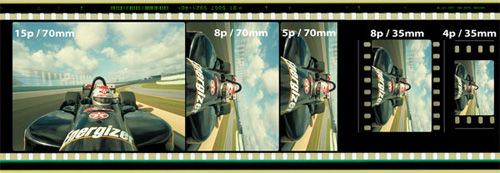 By the mid-70’s IMAX had slowly built itself a circuit of venues for its’ unique films including not only Ontario Place, but the National Air & Space Museum on Washington, DC., the Science Museum of Minnesota, San Diego’s Reuben H. Fleet Space Theater, and other annual fairs and expo sites around the world.
Perhaps you will recall some of their other early widescreen short subjects from the 1970’s, with titles such as, “Energy” (1975), “To Fly” (1976), “Alpha 78” in Omnimax, “Living Planet” (1979).
In the 1980’s they stepped up production, releasing “The Great Barrier Reef” (1980) in Omnimax, “The Eruption of Mount Saint Helens” (1980), and “Space Library” (1980) in Omnimax, was actually thirty films, each approximately one minute in length, to be shown individually as accompaniment to other OMNIMAX films, or screened together as a 30-minute program. By the mid-70’s IMAX had slowly built itself a circuit of venues for its’ unique films including not only Ontario Place, but the National Air & Space Museum on Washington, DC., the Science Museum of Minnesota, San Diego’s Reuben H. Fleet Space Theater, and other annual fairs and expo sites around the world.
Perhaps you will recall some of their other early widescreen short subjects from the 1970’s, with titles such as, “Energy” (1975), “To Fly” (1976), “Alpha 78” in Omnimax, “Living Planet” (1979).
In the 1980’s they stepped up production, releasing “The Great Barrier Reef” (1980) in Omnimax, “The Eruption of Mount Saint Helens” (1980), and “Space Library” (1980) in Omnimax, was actually thirty films, each approximately one minute in length, to be shown individually as accompaniment to other OMNIMAX films, or screened together as a 30-minute program.In the 1980’s and early ‘90’s IMAX grew and expanded, and began making full-length features, while still producing short subjects. And the approach and subject matter covered by their short films expanded as well, now including exploration titles such as “Energy! Energy!”, technology tomes like “Speed”, narrative dramas like “My Strange Uncle”, starring Cloris Leachman, and even animations like “We Are Born of Stars”. Although today, IMAX is predominantly concerned with the production of feature films, it continues to make short subjects like, “Race for Atlantis” (1998), an installation film in Ceasar’s Las Vegas casino, which has also screened in France, and “Ultimate X” (2002), a Disney produced IMAX based on the popular ESPN cable channel’s Summer X Games. |
|
 Sir
Christopher Lee explaining the Showscan concept to the audience in "New
Magic" on the curved screen at "Les Pavillons de la Communication et de
la Créativité" in Poitiers in France, 1992. Image by Thomas Hauerslev Sir
Christopher Lee explaining the Showscan concept to the audience in "New
Magic" on the curved screen at "Les Pavillons de la Communication et de
la Créativité" in Poitiers in France, 1992. Image by Thomas HauerslevIMAX was not the only latecomer onto the scene of widescreen short subject production. My favorite, SHOWSCAN, the process developed by Douglas Trumbull, came to the table last, and like all great film stars, has died young. “Night of Dreams” (1978), their demo film, was released some years later as a stand-alone. “Big Ball” (1984) was technically the first Showscan film. And “New Magic” (1984), starring Christopher Lee, (1984) was the third. After “Let’s Go” (1985) made for EXPO ‘85, in Tsukuba, Japan, came “Deep Sea Rescue” (1986), for which patrons stood for 5 minutes watching the film projected with a fisheye lens onto a domed screen. By 1986, Showscan’s “Tour of the Universe” (1986) was presented in Dynamic Motion, meaning seats that jiggle and move in reaction to the screen…you were riding in a space shuttle. Perhaps drawing a line in the sand of IMAX’s territory, this was originally installed in the CN Tower in Toronto. Beginning in 1992, ALL Showscan films were ride films, meaning presented in Dynamic motion. “The Devil’s Mine Ride” (1992) was/IS my personal favorite, and I REALLY miss the Showscan theater at the Universal City Walk in Los Angeles. The company made over 50 films altogether before filing for bankruptcy in 2002. |
|
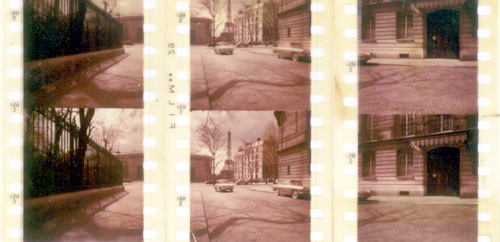 IF you ask me today, to name the most famous, or infamous widescreen short subject films, I include these… IF you ask me today, to name the most famous, or infamous widescreen short subject films, I include these…1. “The Renault Dauphine” - Shot in 1959 in France in Super Cinerama, this commercial accompanied "How The West Was Won" in many of its’ European screenings. 2. "Sky over Holland" (1967) was Dutch-produced and filmed in the Netherlands in Superpanorama 70, originally for Expo ’67 in Montreal. It went on to win an Academy Award nomination for Best Live Action Short Subject. 3. “Rollercoaster” (1986), another coaster film, was produced by Garry Goddard for Landmark Entertainment. Originally made for Six Flags Corporations’ string of amusement parks, this was the first, and still, the only motion picture ever made to incorporate ALL the tricks. It was; • Widescreen • In 3D • In Scent-A-Vision • Multi-track Discrete Sound • and presented in Bodysonic Motion Seats What do you see after seeing something like this? Where do you go? Is it possible to be too thrilled? |
|
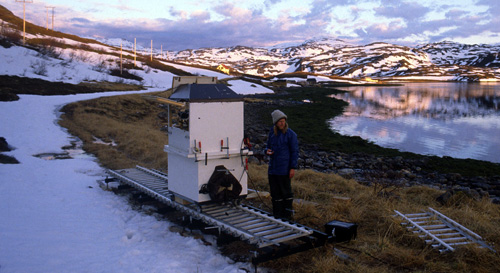 Morten
Skallerud and his camera train during filming of "A Year Along the Abandoned
Road", May 1988. Photo by Knut Skoglund / Camera Magica, Norway Morten
Skallerud and his camera train during filming of "A Year Along the Abandoned
Road", May 1988. Photo by Knut Skoglund / Camera Magica, NorwayI’d also include… 4. "A Year Along the Abandoned Road" (1991) The Award winning Norwegian film by Morten Skallerud, which I had the pleasure of seeing just a few short years ago, right here in Pictureville, an on which an excellent piece is written on the in70mm.com website. And… For honorable mention, let’s not forget all of the 5, 6, or 9 to 11 camera Circle Vision films, all of which were technically short subjects. Beginning with the Disney “Circarama” films, “A Tour of the West” (1955), and “America the Beautiful” (1958), followed by the “Circle-Vision 360” shorts, of which “Italia” (1961), “Magic of the Rails” (1965), “O’ Canada” (1982), “Wonders of China” (1982), “Magic Carpet Round the World”, which Dave Strohmaier edited, (1983), and “Portraits of Canada” (1986) are perhaps the most memorable. There were many Russian Circular Kinopanorama films, not to forget “Russian Roundabout” (1963), and “Circlorama Cavalcade” (1964) both of which had lengthy runs in London, at the Circlorama Theater there. I must mention that both IMAX and Showscan couldn’t resist filming short subjects of both ROLLERCOASTERS and NIAGARA FALLS! IMAX’s “Catch the Sun” (1973) was filmed at an amusement park in Ontario, and Showscan’s “Rollercoaster” (1986) was presented in Dynamic Motion…with seats moving in sync to the picture. IMAX’s “Niagara: Miracles, Myths & Magic” (1987) featured a musical score, by Bill Conti. And Showscan’s “Niagara Wonders” (5/1987) was originally made for the Centennial Theater, at Niagara Falls, New York. I hope I’ve reminded you of some widescreen short subject motion pictures that you’ve previously seen…and made you want to see others. |
|
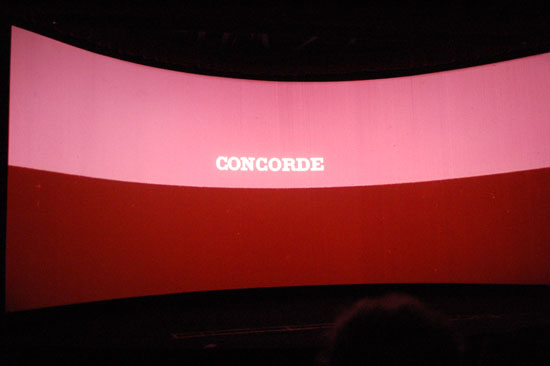 We now come to today’s two films. The first is “Concorde” (1966) An Anglo-French production, directed by Pierre Jallaud, and for Open University Productions. This is a background sketch on the about-to-be-unveiled supersonic airplane that I must admit, keeps you in suspense. Be sure to check out the shoes worn by the wing-makers in Toulouse. We now come to today’s two films. The first is “Concorde” (1966) An Anglo-French production, directed by Pierre Jallaud, and for Open University Productions. This is a background sketch on the about-to-be-unveiled supersonic airplane that I must admit, keeps you in suspense. Be sure to check out the shoes worn by the wing-makers in Toulouse.And the second is “Bridge to Space" (1968). It was directed by “Cinerama Holiday”, "Windjammer" and "Sky over Holland" widescreen veteran Robert Gaffney, for N.A.S.A. and Gaffney’s own Seneca Productions. Shot on Merritt Island and at Cape Canaveral, and inside what was then, and may still be, the largest building in the world. Bob Gaffney told me last week that N.A.S.A. insisted on making a shorter, cut-down version of this picture for television, which he then disowned. Enjoy!!! |
|
|
Go: back
- top - back issues
- news index Updated 22-01-25 |
|
